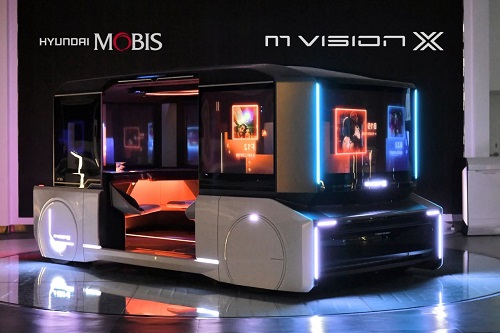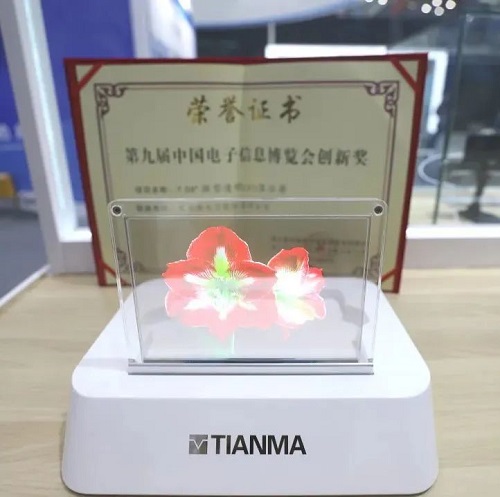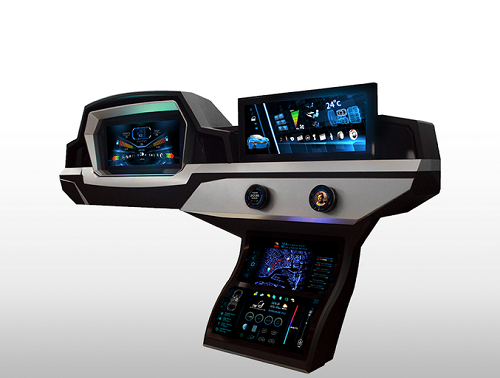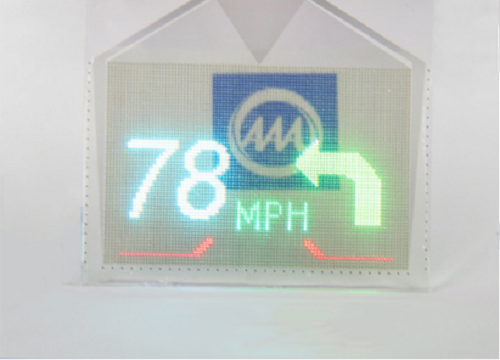Automotive Market is the New Battleground for Mini and Micro LED Technologies
Huawei released a demo video on its autonomous driving technologies on April 15th. Two days later on April 17th, Chinese EV brand Arcfox held a launch event for its luxury crossover sedan Alpha S (α-S). Among the four variants of the Alpha S, the Arcfox Alpha S HBT is equipped with the HI (Huawei Inside) platform developed by Huawei for autonomous driving applications. This is the same model that was shown in the demo video.
Designed to be a mass-produced smart car for urban commute, the Alpha S HBT comes with some of the most advanced specifications and features. It is the first mass-produced car in the world to have three LiDAR sensors. Huawei is attempting to reach the highest level of self-driving to date with the automated driving system that it has developed for the Alpha S HBT. The functions that the HI platform provides include traffic jam pilot for navigating city roads, highway pilot for high-speed automated driving, and automated valet parking. The software operating system of the Alpha S HBT is Harmony OS that Huawei has developed first as an alternative to Google’s Android. Therefore, the car has the potential to sync up with a wide range of end devices designed for the Chinese market. The Alpha S HBT is also the first car that adopts Harmony OS.
In its expansion into the automotive market, Huawei has made clear of its intention to focus on the development of ICT solutions for autonomous driving and V2X. Instead of dabbling in the manufacturing of whole vehicles, the company has opted to become a supplier of key automotive components. Regardless of its activities down the line, Huawei will likely trigger a wave of renewed interest in the development of connected smart cars with its presence in the automotive market.
Automotive Displays Will Embrace Many New Features in the Era of Connected Smart Cars
Many years ago, connected smart cars were something that would only appear in sci-fi movies. At that time, car manufacturers aspired to realize concepts related to driver assistance and autonomous driving but lacked the technological capability. Today, the automotive industry has developed a wide of range of ADAS functions and found new technological advances that will enable autonomous driving. However, car manufacturers have also encountered huge barriers to building self-driving cars and implementing V2X services.
Automotive displays are an indispensable component that has to be mentioned when discussing smart cars because they are responsible for many functions such as human-machine interfacing and infotainment. The introduction of a new generation of automotive displays is made possible through the integration of the advances in different technological fields as well as the continuous efforts to improve user experience.
Currently, the development of automotive displays is trending toward larger screens, multiple screens, higher resolution, higher level of interactivity, diversification in forms, etc. Display panel manufacturers are also incorporating many new features into their automotive offerings.
CID: Car manufacturers are replacing the traditional center console with a large center information display (CID) with touchscreen control. Compared with physical knobs and buttons, a display with a touchscreen interface is more intuitive for users and offers a greater variety of interactions.
According to the information on Arcfox’s official website, the Alpha S has synergized with Harmony OS to form a 5G automotive ecosystem. The fast internet connection enabled by 5G allows the driver of the Alpha S to be constantly updated with real-time information about the state of the vehicle, road conditions, etc. Furthermore, the CID of the Alpha S is 12.69” in size and 4K in resolution. All in all, the combination of 5G and the large CID will help the driver “see much further” and control every aspect of the vehicle operation with just one screen.
(Source: Arcfox.)
With the introduction of CIDs, car manufacturers and component suppliers in the automotive industry are also starting to add new interface technologies into different types of in-vehicle display systems. Gesture control, facial recognition, and voice assistant have also been implemented in addition to touchscreen control. These display systems also provide a lot more than the standard control functions and instrumentation. They help with trip planning, recommend restaurants, and host different cloud-based services. In a sense, the car itself has become an intelligent assistant.
Transparent Display: The arrival of transparent displays has made certain innovative designs possible in the automotive industry. Traditional car windows can be replaced with transparent displays that not only have the same level of light transmittance but also bring about new kinds of interactions with drivers and passengers. For example, side and rear windows can be transformed into mobile billboards.
Just before the opening of Auto Shanghai 2021, Hyundai Mobis held a press conference to present its strategy and new technologies. A highlight of the conference was the unveiling of a concept car called M.Vision X. It uses multiple transparent displays to form a 360-degree field of vision. The passengers of this vehicle can look at the changing sceneries outside the car windows or watch movies by turning the car windows into video screens. The layout of the passenger seats can be rearranged so that the passengers face each other and are surrounded by the transparent displays on all sides.
▲ M.Vision X is a shared mobility concept from Hyundai Mobis. (Source: Hyundai Mobis.)
Turning to other car manufacturers, Ford for a while has been developing a smart car window that would allow blind or visually impaired passengers to use their sense of touch to experience the passing landscape. The prototype of this technology has been revealed. It is a display system that uses a camera to capture the outside scenery and then turns the image data into tactile feedback.
Honda, too, is developing car windows that contains cameras and sensors. Besides serving as event data recorders, these modified car windows also have many other potential functions such as image capture, distance gauging, and even translation.
Additionally, a transparent display installed on the A-pillar can significantly improve driving safety by eliminating the blind spot.
Smart Sunroof: This type of vehicle glass has been a standard feature for high-end vehicle models. Apart from providing a view of the sky, a sunroof also helps reduce the temperature inside the vehicle, lets more fresh air into the cabin, and contributes to an increase in the sense of space. However, the role of sunroofs has evolved with the advent of technologies related to connected smart vehicles. They are getting larger, incorporating more functions, and offering a higher level of interactivity.
Take panel manufacturer BOE as an example. On October 22nd, it held a joint exhibition with BMW to present advanced technologies for automotive displays. Among the items showcased was a smart dimming solution that uses dye liquid crystals to achieve either the dimming of the entire surface of a sunroof or a part of it. Compared with other “smart sunroofs”, this concept from BOE has several advantages such as high transparency, low power consumption, and fast response. It offers automatic or manual adjustment of light transmittance. Moreover, it can be combined with low-e (or tinted) glass to further enhance the comfort of the in-vehicle environment. In addition to the sunroof, the solution is suitable for side windows and other types of vehicle glass as well. At the same time, it can be integrated into a smart cockpit system, thereby opening up new applications pertaining to intelligent and interactive driving experience.
Can Mini/Micro LED take the cake in automotive display with technology roadmap yet to set in stone?
Automotive display has become the 5th largest small and medium panel market after smartphones, tablets, notebook, and monitors, whereas the “multiple displays in one vehicle” property of smart vehicles has actuated a blowout growth in the market of automotive display.
Objectively speaking, each of the numerous display technology is paired with different application scenarios based on performance requirements, so who will be the new favorite in the market of automotive display?
Owing to technological maturity and cost advantages, LCD technology is the current leader in automotive display, and the development of the automotive market has prompted a gradual marching of OLED and Mini/Micro LED in high-end automotive displays. Among them, OLED excels remarkably in transparency, flexibility, and allotypic property, though the issues surrounding burn-in and lifespan remain unsolvable after years of refinement.
In comparison, Mini/Micro LED possess ultra-high resolution, high reliability, high brightness, ultra-wide color gamut, low power consumption, and ultra-fast speed of response, which fully satisfy the requirements of automotive display.
Panel suppliers are exceedingly spontaneous in the arrangement of Mini/Micro LED automotive display, of which the automotive Mini LED solution of TCL has been certified by the Automotive Electronics Council Qualification, and has unfolded commercial incorporation with multiple domestic and overseas companies on Mini LED.
BOE Technology now has reserves in the mass production technology for glass substrate mini LED backlight. As reported, automotive display products adopted with the mini LED technology of the company is able to achieve refined dimming in thousand-level zones and million-grade ultra-high contrast for a purer and more natural display effect.
Tianma pointed out in its 2020 annual report that Mini/Micro LED has become a focus for the industry, and showcased the 7.56” Micro LED display that the company worked on with PlayNitride at CITE 2021, which has a light transmittance of 60% and an ultra-thin bezel at 0.68mm, making it a suitable candidate for automotive displays.
▲ Tianma’s 7.56” Micro LED display. (Source: Tianma Microelectronics.)
After releasing the first 12.1” full-color active Micro LED automotive panel in 2019, AUO had added two production lines for automotive panel modules during the second quarter of 2020, then showcased its Micro LED automotive display products at Touch Taiwan 2021. Among them, the driver’s seat and the front passenger’s seat are respectively configured with a 12.1” 169PPI Micro LED display, and the central control display is adopted with a 9.4” 228PPI flexible Micro LED display that fits better with the interior of the vehicle. The circular Micro LED display on the dial is the first 1.39” 338PPI circular display of AUO, which offers a clear view of the items and information on the dial, and provides additional functionalities to the dial.
(Source: Touch Taiwan 2021 Official Website.)
Yang Chu-hsiang, President and COO of Innolux, pointed out during the investor conference on March 3rd that the future demand for smart cockpits and the integration of digitalized information will introduce growth opportunities for display panels of high added values. It is reported that the Mini LED backlight technology of Innolux is targeted at high-end automotive panel products, and has been shipped in advance to critical automotive manufacturers from Europe, US, and Japan.
PlayNitride signed with the Industrial Technology Research Institute (ITRI) on December 24th 2020 for a 4-year collaboration, which marked the initiation for the two parties in the development of Micro LED applications on AR, MR, and automotive panels.
In terms of chip suppliers, HC Semitek had lowered the production capacity for its low end LED chips in 2020, and accelerated on the arrangement for Mini/Micro LED display and the third generation semiconductor, of which the Mini LED backlight chips have been adopted by end products such as iPad, notebooks, TVs, and automotive applications.
A small batch of the Mini LED backlight product by Aucksun has entered production in first-tier module makers, and will be primarily adopted in automotive systems.
As for packaging houses, Nation Star released its first Micro LED product nStarI in June 2020, which adopts glass substrate, with a full-color display, and a transparency of 60%. The product is expected to achieve applications in HUD.
▲Nation Star’s nStarI. (Source: Nation Star)
coREACH mentioned in its 2020 annual report that the Mini LED display technology of the company was selected as a major technology in Anhui, and has now entered the R&D phase, with application markets including automotive display.
It is evident that the entire display industry, from panels to chips and packaging, is vigorously actuating the application of Mini/Micro LED on automotive displays.
The extremely long certification cycle of automotive products compared to traditional consumer electronics has resulted in the sluggish adoption for smart automotive products despite the aggressive promotion in Mini/Micro LED automotive displays, though the longer lifespan, higher technical content, and the comparatively better profit of automotive display products are expected to introduce a new round of growth for businesses, and that is why the product has become a battleground for various major panel suppliers and companies in the supply chain.
TrendForce has also pointed out that the demand in the automotive LED market has elevated drastically alongside the development in advanced technology such as smart headlights, central tunnel taillights, ambient lights, and HDR automotive display, and the technology of Mini LED and Micro LED serves a critical role amidst the relevant progress.
The arrival of the smart vehicle era has endowed new functions and missions for automotive displays, and it is expected that an increasing number of Mini/Micro LED monitors will be applied in smart vehicles under the collective propulsion of the display supply chain to provide an even more abundant and convenient riding experience for the users.
(Author: Lynn at LEDinside.)
















